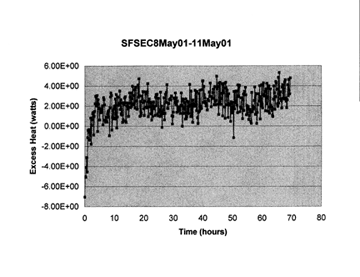 |
Infinite Energy Device Update
Published in Issue #38, July/August
2001
New Energy Research Laboratory Device and
Process Testing Update
by Ken Rauen
Several sonofusion test runs here at New Energy
Research Laboratory with a titanium target were reported in Issue
No. 37 to produce excess heat in the 3 to 4 watt range. One produced
3.1 watts after the reactor joule heater had been turned off, which
was a surprise to us, because Roger Stringham's experience showed
that a reactor temperature around 100°C was necessary and a
colder reactor would quench the reaction. As of the last issue,
we did not know what to make of this apparent excess heat output.

A
D2O run at 1500 V peak ultrasonic exitation. A
portion of one excess heat run is shown from it's data aquisition
computer database file. On the graph, excess heat (the noisy
trace) has a vertical scale of 2 W per division and the reference
center line is 0.0 W. |
We now accept the results of that run to be genuine
excess heat. Many more tests have been conducted under many different
conditions in an attempt to kill the excess heat phenomenon, and
it took many tests to find that out. We want to know which conditions
produce excess heat and which do not. We also want null tests to
be reliable so we can identify the on/off controlling parameters.
The more conditions we can identify which do not produce excess
heat, the more confident we are that our methodology does not have
a systematic error creating an artifact, a false positive signal.
A balance is necessary; repeatable zero tests are needed, and of
course, repeatable excess heat events are needed also. We now have
many of both.
NERL's sonofusion research has been perplexing. Cold fusion categorically
has been extremely difficult to reproduce, and that had been NERL's
experience until recently. Since Issue No. 37 appeared, and for
a short time, we were faced with the novel experience of always
finding excess heat, and we could not find conditions that would
not produce excess heat except by turning off the ultrasonic oscillator.
It was a very strange feeling. We were searching for systematic
errors for a month. Finally, we found some conditions which do not
produce excess heat and could verify the system calorimetry with
more than the joule heaters in the oscillator calorimeter and the
reactor calorimeter.
It turns out that excess heat in the 2 to 4 watt range can be produced
not only by Roger Stringham's method of ultrasonic activation with
applied argon pressure of up to 50 psig and operating just over
100°C, but also by: 1) no applied joule heat and temperatures
close to room temperature; 2) argon gas pressure from 0 to 50 psig;
3) ultrasonic power driven with transducer voltages from 600 VAC
peak up to 1,500 VAC peak; 4) target or no target in the reaction
chamber, and 5) heavy water, normal distilled water, or deuterium
depleted (3 ppm deuterium) water. See the display of part of one
test run showing excess heat. There seems to be no significant difference
in the excess heat by any method, though we have not statistically
analyzed any data. Roger believes these all on results demonstrate
what he wanted with the ultrasonic ring-down pulse; that sweep of
operating conditions runs through the unknown but expected "sweet
spot" in every test, and in every ultrasonic burst. What puzzles
us most is the apparent lack of correlation between excess heat
and deuterium concentration. One of our peers in the scientific
community thinks we might have a systematic error, since there is
no apparent correlation of excess heat with deuterium concentration
in the water.
We searched for good zero conditions just as much as for the esteemed
excess heat. Nulls were found with: 1) an empty chamber (though
not necessarily perfectly dry), and 2) replacing the piezo transducers
with dummy resistor loads. The empty chamber has shown us that the
Ohio Semitronics wattmeter, which monitors the input electrical
power to the oscillator (inside its own separate calorimeter) has
a 0.9 watt error, which makes it read the real power too low by
that amount, so the computer which monitors the entire measurement
system calculates a false excess heat of about 0.9 watts, which
has ranged from 0.4 to 1.0 watts excess heat. This means our 2 to
4 watts of excess heat results should really be 1 to 3 watts of
excess heat. The numerous empty chamber tests were supported by
tests with the resistive loads on the oscillator. Now we are sure
that excess heat is occurring reliably, and that our test apparatus
is performing well, except for the OSI error, which we do not want
to tamper with; we know its error and it is consistent. We want
to leave it where we know it is.
As we go to press with this issue, we are testing a new wattmeter
that is custom-made by Pioneer Microsystems, Inc. of Pittsburgh,
Pennsylvania. So far, the new wattmeter reads the same as the OSI
reading minus the oscillator calorimeter heat loss. Piezo loading
is the next level of testing.

|

